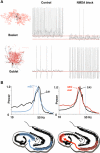Are different rhythms good for different functions?
- PMID: 21103019
- PMCID: PMC2987659
- DOI: 10.3389/fnhum.2010.00187
Are different rhythms good for different functions?
Abstract
This essay discusses the relationship between the physiology of rhythms and potential functional roles. We focus on how the biophysics underlying different rhythms can give rise to different abilities of a network to form and manipulate cell assemblies. We also discuss how changes in the modulatory setting of the rhythms can change the flow of information through cortical circuits, again tying physiology to computation. We suggest that diverse rhythms, or variations of a rhythm, can support different components of a cognitive act, with multiple rhythms potentially playing multiple roles.
Keywords: beta; brain rhythms; gamma; oscillations.
Figures






References
LinkOut - more resources
Full Text Sources

